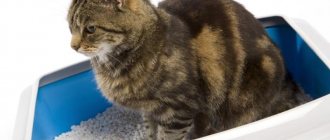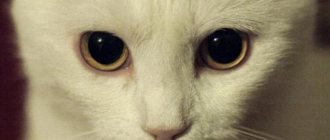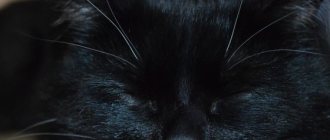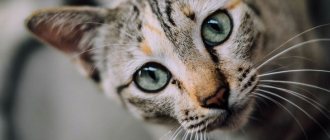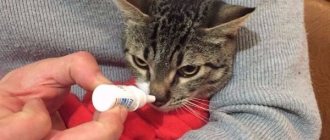© JaneA Kelley, September 2012
A cat's whiskers are more than just decoration. They are like a Swiss army knife for a soldier - a whole set of tools that provide orientation and perform communication functions. The mustache not only helps determine one’s position relative to other objects, serves as a measure to assess the ability to pass through a hole, but also allows one to express emotions and mood. Here are some interesting facts about cat whiskers.
The mustache hairs are extremely sensitive.
The roots of a cat's whisker hair are located much deeper in the skin than the hairs of its fur, and the area around the roots is very rich in nerve endings and blood vessels. This gives them such sensitivity that they can detect the slightest vibrations in the air. Because of this sensitivity, cats may experience pain if their whiskers get caught on something, such as when eating from a small but deep bowl. Pressure on the whiskers can be alarming, so use wide plates or flat feeders for food.
What to do and how to prevent the problem?
If your cat's whiskers are regularly falling out, you should consult a veterinarian as soon as possible to assess the severity and source of the problem. After laboratory and instrumental diagnostics, the specialist selects therapy. Medications are often prescribed based on the cause of mustache loss. The problem can be overcome with the help of the following medications:
- antibacterial;
- anthelmintic;
- antiviral;
- antihistamines.
In order to eliminate and prevent further whisker loss, it is necessary to adjust the cat’s daily diet. It is recommended to feed your pet a variety of foods filled with vitamins and minerals. Animals should avoid eating foods that cause allergies. It is possible to prevent violations with early diagnosis and treatment of viral, infectious and fungal diseases. It is also worth getting vaccinations and deworming.
Mustaches can change color.
Cats' whiskers are usually white. However, the mustache is often black or red. Sometimes some of the mustache is black, some is white, sometimes different hair has different colors. It happens that one hair is painted in several colors. Don't be surprised if your black cat develops white hairs in her whiskers as she ages: cats also begin to turn gray as they age, although this is not as noticeable in non-uniform colors. It happens, on the contrary, that the mustache turns black - this does not indicate health problems.
Posted by Kotizm March 6, 2016
Many people wonder whether cats have black whiskers and why they fall off and break off. It will be equally interesting to find out what they are correctly called and what function they perform in cats, cats and kittens, because few of those who keep such cute pets in an apartment or private house know about this.
The article discusses basic questions about cat whiskers, interesting facts and everything that every cat lover should know about their pet, so that in case of any problem, they can correctly provide help and know what needs to be done.
What are cats' whiskers called?
Whiskers in cats are scientifically called vibrissae. It is believed that a cat's whiskers are thickened and coarse hairs endowed by nature with mechanical sensitivity.
Is it possible to cut or trim a cat's whiskers?
Trimming a cat's whiskers is strictly contraindicated. A cat without a mustache will not be able to navigate in space. Whiskers serve as tactile and olfactory receptors.
Why does a cat need mustaches and eyebrows, what are they needed for, what are they responsible for
Whiskers and eyebrows in cats (more correctly whiskers) are needed so that the animal can navigate in space. These are natural navigator antennas.
Why do cats and kittens' whiskers break, fall out, and become long?
Periodic loss of whiskers in cats, with replacement with new ones, is the norm. If the whiskers fall out or break off intensively, this is a sign of a malfunction in the animal’s body.
Mustache loss can be caused by: - lack of vitamins; - due to food allergies; — malfunctions of the thyroid gland; - skin diseases of a fungal nature or caused by parasites (notoedrosis or microsporia).
It is paradoxical, but true, that long and thick whiskers in cats are not always a sign of excellent health. Scientists have found that their carriers often have impaired vision.
What happens if you cut a cat's whiskers?
Some owners wonder whether it is possible to cut the whiskers. It happens that a small child or an unaware adult trims the pet's whiskers. Of course, this is not fatal.
READ Californian breed rabbits maintenance and feeding
Cats' hairs renew themselves every few months, and after some time the hairs will grow back. However, at first the pet’s behavior becomes inappropriate.
In other words, a pet with cut off whiskers is capable of harming itself. Coarse hairs can break off on their own. Important points to remember:
- You cannot trim a cat's whiskers. The help of the whiskers is invaluable for the animal.
- Although the whiskers grow back, time spent without them will affect the animal's mood. Stress and depression may occur, not to mention the numerous injuries he will inflict on himself.
As already mentioned, a trimmed mustache grows back. Lost, broken vibrissae are constantly renewed and grow again. But this does not mean that they need to be trimmed or straightened in order to grow better. A lost whisker will simply cause less harm to your pet.
Functional significance of whiskers in cats
A cat's whiskers are an organ of touch that is located not only on the muzzle, but also in certain places throughout the body, on the ankles and paw pads. Vibrissae have a fairly wide range of purposes; they perform the following tasks:
- Allows you to navigate in the surrounding space;
- With their help, cats easily avoid obstacles without crashing into them;
- Using vibrissae, the cat estimates the area of the room, as well as the speed of the wind flow and the strength of the wind;
- Serve as a warning element of the individual’s mood for others;
- With its whiskers, a cat detects which direction an object is moving or a sound is coming from;
- Determine weather conditions;
- Serve as an organ of vision in blind individuals.
Why does a cat need mustaches and eyebrows?
Why does a cat need whiskers? They are an important organ of touch.
Many animals that feed on their mother's milk have similar adaptations. The hardest and longest whiskers of a cat help the animal navigate in space. These hairs are located on the cheeks, on both sides of the nose, above the eyes, on the chin and tail.
Cat's whiskers also have another name that is not known to everyone. Scientifically, they are called vibrissae. Cats touch different objects with them to determine their size. For example, before climbing into a hole, a cat checks with whiskers whether it is of sufficient size.
The pet may not have them at all. Due to the nature of the breed, hairless cats may have broken whiskers, curled or not have them at all.
Sometimes the absence of vibrissae occurs in furry representatives of the cat family. This is due not only to the breed, but also to a kind of mutation.
As already mentioned, the whiskers of cats are located not only on the face, but also on the paws and tail. How many whiskers a cat has along the body depends on the breed and the specific representative.
The whiskers on the paws and tail are not so long; they can be distinguished by their greater rigidity. The number of rows of a cat's whiskers determines how well they navigate the world around them.
Causes of loss
If your cat's whiskers fall out, don't panic right away. First of all, having noticed such a phenomenon, it is necessary to observe for some time the behavior, general condition of the pet, and whether a new whisker grows in place of the one that fell out. In most cases, the loss of a mustache is not associated with any disease or abnormality in the body. Some pets lose them as a result of fights with other individuals, others are too curious and come close to the fire, after which the whiskers simply become scorched.
It is normal for cats to change their whiskers. Vibrissae can fall out at any time, regardless of the molting period of the individual.
In some cases, disappearance of whiskers may indicate developing health problems in the animal. Such reasons include the following factors:
- hypothyroidism is a disease associated with increased activity of the thyroid gland;
- infections of bacterial etiology;
- the presence of parasites in the body;
- diabetes of any type;
- allergic reaction;
- metabolic disorder.
Why do cats' whiskers turn black or white?
The color of the whiskers directly depends on the color of the animal itself. They can be white, black, red or several colors at the same time. Usually a black cat has black whiskers, but sometimes white whiskers are normal. In some breeds they turn black over time.
If a cat with a white mustache has acquired a black color, this phenomenon also does not mean anything terrible, just a normal change in hair pigmentation. You should be wary if the color, on the contrary, changes to white. Sometimes this can be a symptom of a disease. Therefore, even with a slight deviation, it is worth consulting with a veterinarian.
Symptoms of deviations
If a cat's whiskers have disappeared, then the specific disease can be determined using the accompanying symptoms. For example, with hypothyroidism, there is a significant deterioration in the appearance of the coat. The cat becomes too active and nervous. The pet constantly requires a lot of food, but at the same time its body weight decreases. There is constant thirst. In rare cases, vomiting and diarrhea may occur. If the absence of whiskers is accompanied by scratching and wounds on the face, then this is a clear sign of parasites. When a pet has problems with bowel movements, diabetes can be suspected (most often diagnosed in adults and old animals). An allergic reaction is manifested by loss of whiskers and hair, itching, increased salivation, redness of the mucous membranes, and oozing secretions from the eyes. Failure in metabolic processes is often accompanied by an increase in temperature and changes in heart rate.
What could be the cause of the plaque?
Few owners have not encountered a situation where they discovered black plaque in a cat’s ears. The reason could be very simple - the animal simply got dirty and did not wash its ears. In this case, the owner needs to wrap the cat in a towel or blanket, drop a little Vaseline or vegetable oil into his ears to soak the plaque, and then carefully remove the dirt with a cotton swab.
Do not clean your cat's ears with water.
If after some time the cat’s ears again turn out to be covered in black plaque, then this is nothing more than a sign of a disease that needs to be treated urgently. Most often, the danger comes from ear mites. This disease is otherwise called “ear scabies,” in which the animal experiences discomfort and can even scratch its ears until it bleeds.
Read this article on how to get rid of ear mites on your cat.
Treatment methods
If the owner discovers that his pet is losing important elements of touch, then it is necessary to assess the general condition of the animal. In case of previous activity, there is no need to worry. It should be noted that some breeds tend to break their whiskers. In most cases it is noted among sphinxes. If the loss of whiskers is accompanied by accompanying symptoms, you should visit a veterinarian. The earlier the disease is diagnosed, the easier it is to cope with it. The goal of therapy is to stop the loss of whiskers, eliminate concomitant symptoms and the underlying disease. When visiting a veterinary clinic, an examination and tests are prescribed. Based on the results obtained, effective treatment is determined. The owner needs to feed his furry friend properly, carry out preventive measures to combat parasites, and take him for examination to the veterinarian.
Proper care, nutrition and a caring attitude will allow the cat to recover in a short time, a healthy pet will delight the owner and all household members.
What is the difference between a planned mustache change and a pathological one?
Losing a cat's whiskers is not a symptom that you should panic about. However, if it is accompanied by other symptoms, you should immediately consult a doctor and identify the underlying cause.
An important aspect is the extent of vibrissae loss. During a planned change, a cat cannot lose all its whiskers at once. The cat's whiskers grow for some time, serve the cat, and then fall out. A new one begins to grow in its place. This process is characterized as natural; therefore, there is no need to interfere with it.
During a planned change, a cat cannot be left without a whisker; it is almost invisible to humans
Any of the symptoms is a reason to contact your veterinarian.
READ Wild cat ocelot in the wild

